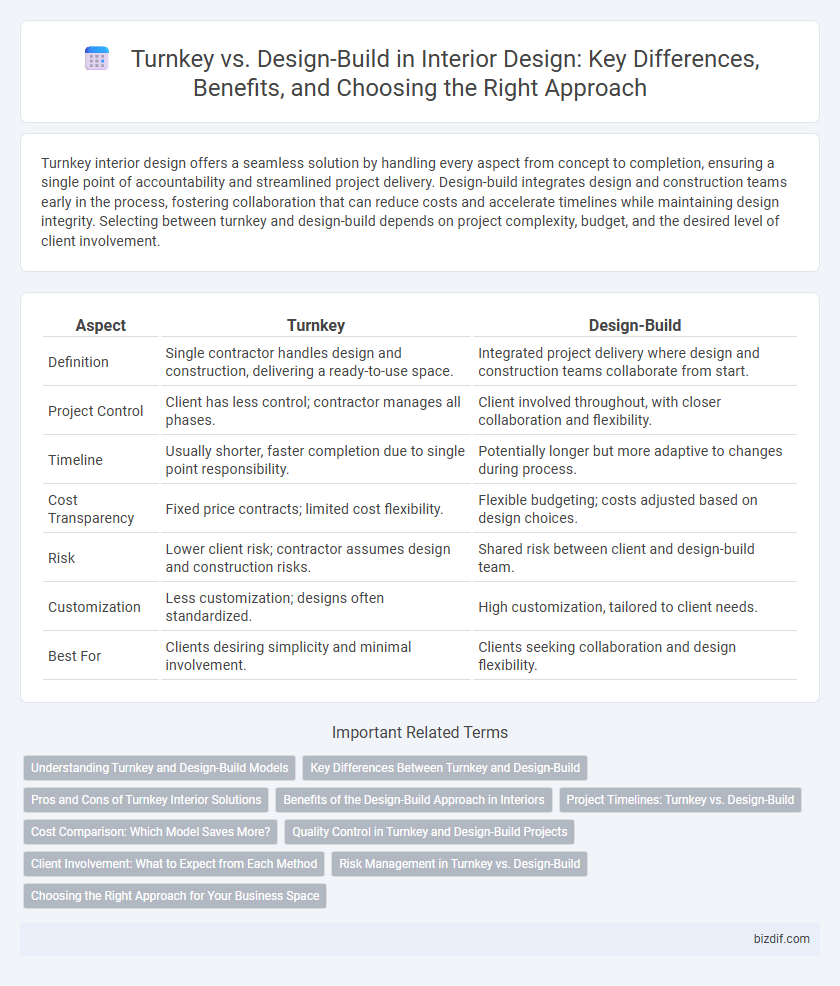Turnkey interior design offers a seamless solution by handling every aspect from concept to completion, ensuring a single point of accountability and streamlined project delivery. Design-build integrates design and construction teams early in the process, fostering collaboration that can reduce costs and accelerate timelines while maintaining design integrity. Selecting between turnkey and design-build depends on project complexity, budget, and the desired level of client involvement.
Table of Comparison
| Aspect | Turnkey | Design-Build |
|---|---|---|
| Definition | Single contractor handles design and construction, delivering a ready-to-use space. | Integrated project delivery where design and construction teams collaborate from start. |
| Project Control | Client has less control; contractor manages all phases. | Client involved throughout, with closer collaboration and flexibility. |
| Timeline | Usually shorter, faster completion due to single point responsibility. | Potentially longer but more adaptive to changes during process. |
| Cost Transparency | Fixed price contracts; limited cost flexibility. | Flexible budgeting; costs adjusted based on design choices. |
| Risk | Lower client risk; contractor assumes design and construction risks. | Shared risk between client and design-build team. |
| Customization | Less customization; designs often standardized. | High customization, tailored to client needs. |
| Best For | Clients desiring simplicity and minimal involvement. | Clients seeking collaboration and design flexibility. |
Understanding Turnkey and Design-Build Models
Turnkey and design-build models streamline interior design projects by combining design and construction services under one contract, reducing coordination complexity and project timelines. The turnkey model delivers a fully completed space ready for immediate use, often preferred for projects requiring minimal client involvement during execution. Design-build emphasizes collaborative customization between designers and builders, allowing clients to participate actively and adjust designs throughout the project lifecycle for tailored results.
Key Differences Between Turnkey and Design-Build
Turnkey projects in interior design involve a single contractor managing everything from concept to completion, providing clients with a finished, ready-to-use space, while design-build integrates both design and construction services under one contract but emphasizes continuous collaboration. Turnkey contracts typically mean less client involvement during construction, whereas design-build allows for ongoing client input and flexibility throughout the process. Cost control and timeline predictability are stronger in turnkey projects, whereas design-build offers greater adaptability to design changes and complex requirements.
Pros and Cons of Turnkey Interior Solutions
Turnkey interior solutions streamline project management by providing a single point of contact, ensuring faster completion and reduced client stress. However, this approach can limit customization options and sometimes lead to higher initial costs compared to design-build methods. Clients benefit from cohesive design execution but may face less flexibility in material and design choices.
Benefits of the Design-Build Approach in Interiors
Design-build in interior design streamlines project delivery by integrating design and construction teams, reducing communication gaps and accelerating timelines. This approach enhances cost control through unified budgeting and allows for greater flexibility in design adjustments during construction. Clients benefit from a single point of accountability, improving overall quality and ensuring cohesive execution from concept to completion.
Project Timelines: Turnkey vs. Design-Build
Turnkey projects typically offer shorter project timelines by providing a single contract for design and construction, streamlining communication and decision-making. Design-build methods integrate design and construction teams from the start, which can reduce delays and expedite project completion through collaborative workflows. Understanding the impact of these approaches on scheduling helps interior designers optimize resource allocation and meet client deadlines more effectively.
Cost Comparison: Which Model Saves More?
Turnkey projects often streamline costs by consolidating design and construction under a single contract, minimizing change orders and budget overruns. Design-build models can offer competitive pricing through integrated communication between designers and builders, preventing costly delays and misaligned objectives. Evaluating specific project scope and complexity is crucial for identifying which approach yields greater cost savings in interior design ventures.
Quality Control in Turnkey and Design-Build Projects
Turnkey projects offer stringent quality control through predefined standards and full contractor responsibility, ensuring consistent results aligned with client specifications. Design-build projects integrate design and construction teams, enabling real-time collaboration that enhances quality control by addressing issues promptly during all phases. Both approaches prioritize quality but differ in execution, with design-build providing dynamic oversight and turnkey delivering comprehensive, contractually guaranteed standards.
Client Involvement: What to Expect from Each Method
Turnkey projects typically require minimal client involvement as the contractor manages all phases from design to completion, delivering a ready-to-use space. Design-build methods encourage active client participation throughout the process, fostering collaboration between designers, builders, and clients to tailor the project to specific needs. Clients opting for design-build can expect regular updates and input opportunities, whereas turnkey clients experience a more hands-off approach until final delivery.
Risk Management in Turnkey vs. Design-Build
Turnkey projects minimize client risk by transferring full responsibility for design, construction, and completion to a single entity, ensuring streamlined communication and accountability. Design-build allows for collaborative risk sharing between designers and builders, fostering innovation but requiring careful contract management to mitigate disputes. Effective risk management in both approaches hinges on clear scope definition, contract clarity, and proactive issue resolution to avoid budget overruns and delays.
Choosing the Right Approach for Your Business Space
Turnkey projects offer a streamlined solution by delivering fully completed interior spaces, reducing the need for client involvement and accelerating project timelines. Design-build integrates design and construction under one contract, enhancing communication and flexibility to tailor the space to specific business needs. Selecting between turnkey and design-build depends on the desired level of control, customization, and project complexity for optimizing your business environment.
Turnkey vs Design-Build Infographic

 bizdif.com
bizdif.com